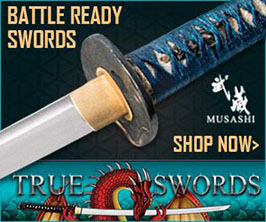- Home
- Maintenance & Repair
- A Knight’s Journey: Obtaining the proper draw on your sword.
A Knight’s Journey: Obtaining the proper draw on your sword.
by David L. Hayter
(Michigan, USA)

"Renaissance," French for "rebirth," perfectly describes the intellectual and economic changes that occurred in Europe from the fourteenth through the sixteenth centuries.
During the era known by this name, Europe emerged from the economic stagnation of the middle Ages and experienced a time of financial growth. Also, and perhaps most importantly, the Renaissance was an age in which artistic, social, scientific, and political thought turned in new directions”. (http://www.learner.org/exhibits/renaissance/)
“The end of the Renaissance In both Italy and Northern Europe, the Renaissance had stirred a burst of creative activity. The work of the later German and Flemish masters marked its final phase. During the 1600's, new ideas and artistic styles appeared. Nonetheless Renaissance ideals continued to influence European life and thought. The Renaissance belief in the worth and dignity of the individual played a key role in the rise of democratic ideas” (WH, p. 358). Write Design Historical and Culture.
We have considered joining the Current Renaissance. Which appears to embrace a more lucid perspective, which is more humanistic and less materialistic and self-serving. It represents a change in values and restores a more meaningful life less myopic in its orientation and more global in its perspective.
I love the sword and especially you’re the Darksword marker’s mark. There are numerous positive reviews of the quality of these functional swords. I am planning on using this at our local renaissance fair. On a more technical note, I made some modifications to the scabbard, which I thought I would like to share with you.
I wanted my sword to fit tightly into the scabbard. I absolutely hate running into the throws of battle and finding out in the mist that I had dropped my sword somewhere along the way. Although, I know how to retrace my steps it gives my opponent the impression that I am simply running away.
Thus, I decide to take some spray form insulation and fix a long extension tube down to the bottom of the scabbard. This material called Great Stuff 3-M and expands quite nicely. I tried to estimate and to add only enough to go about 1/4 of the way up the scabbard when it was fully expanded.
Note: on the picture where I connected the tube, which came with the product to my own tube I made, a snug fit and tried to straighten the tube to go down the scabbard. What you may not be aware of is that I also applied some tape to the connection. It was my effort not to blast the tube down into the scabbard and have it sticking down there with the foam expanding inside. This precaution comes from years of not thinking about the Peter Principle ahead of time.
I then liberally oiled the sword up and slide the sword down the scabbard so the sword inside the scabbard would shape the foam. Waiting about 3 or 4 minutes and initially withdrew the sword from the scabbard. This was very risky business in two major ways 1) the foam would have expanded into the area where the sword was then withdrawn. 2) Another real major problem was that the foam was beginning to stick to the sword itself.
Note: This may offer you a perspective of the expansion of the foam. It went through the little tube on the left hand side and expanded to what you see on the lower right hand side. I would guess maybe three to one ratio.
Now very important: I had a quart of Acetone which was able to dissolved the foam while it was still tacky otherwise it would have to be mechanically removed and would ruin the polishing on the sword.
I was able to clean the sword well. Then re-oiled it and reinserted it in the scabbard in which the foam was still drying. Well, I still did not trust my experiment so after another 3 or 4 minutes withdrew the sword assuming it was be totally protected by the oil... Not really, but less then a mess then the first time. I quickly cleaned off the swords again with the acetone removing any trace of the foam... I decide at this point not to reinsert them and deal with that mess again.
The next day I tried to reinsert the sword and it was really tight because the foam had still expanded slightly. Again, I oiled the sword and reinserted it deeper and deeper and working it out. This took a while, back and forth and re-oiling etc. Probably an hour. because the sword was sharpen so well I was able to expand the throat edge so it would slip in and out easily...
Two very important lessons I learned is for sure have a lot of Acetone.... Nothing else will dissolve this foam and has to be removed when it tacky has not hardened.
Next, do not fill up the scabbard too much.... and maybe you have other sword templates to use other then the polished sword....
I was working the sword forward and turning it around backwards in the scabbard to give an easy but tight pulls out. This strategy worked over all. The first several times with the oil on the blade. Then wiping the blade clean of oil I did this several time to remove as much of the oil as possible. I a then applied several coats of wax and went through the same procedure. Finally, wiping everything down I applied the final coats of wax and let it air dry for 24 hours. Finally, but a very important caution note the blade came with a beautiful polish and was as far as I could tell scratch free. After running the blade in and out of my scabbard numerous times various slight scratches appeared from either the form process or perhaps the blade had picked up some dirt as I was running in and out of the scabbard. So please be aware of this and decide ahead of time whether you need a pristine blade. Some other scratched also did appear as I was outside swinging the sword wildly through the forest.
Nevertheless, this will work well for my needs at the renaissance fair.













